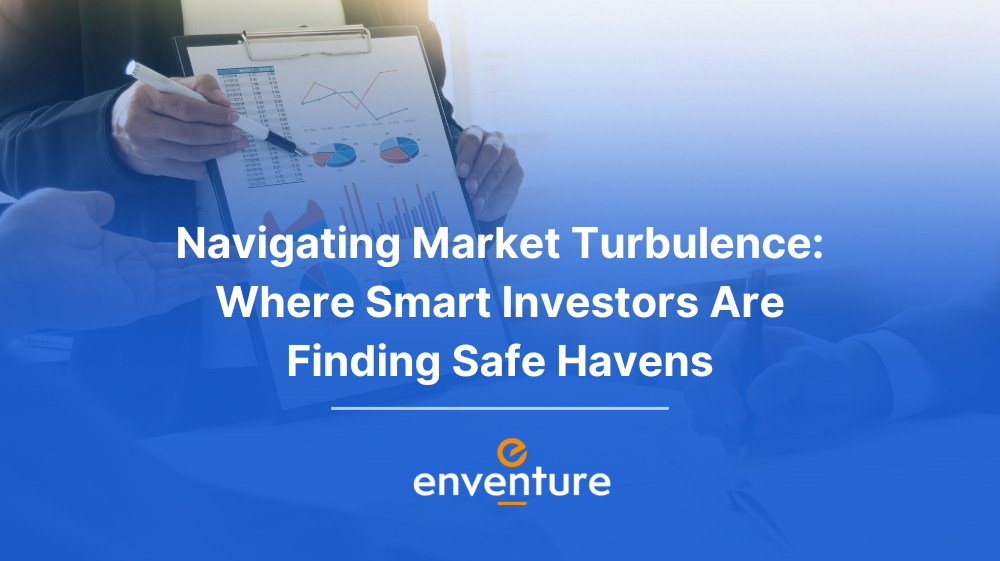Discover how savvy investors are navigating market volatility by turning to safe-haven assets like CDs, private markets, real estate, and more in today’s uncertain economic landscape.

Navigating Market Turbulence: Where Smart Investors Are Finding Safe Havens
In the wake of heightened tariff tensions—most recently the Trump administration's decision to impose a steep 145% tariff on certain Chinese imports—investors have been forced to re-evaluate their strategies. Market volatility has surged, and the search for financial stability is back in focus. But what truly counts as a “safe haven” in this unpredictable environment? I’ve spent the past week speaking with seasoned professionals across the financial spectrum to explore where capital might find shelter—and even opportunity—amid the chaos.
Stability in Simplicity: CDs and Real Estate
Odysseas Papadimitriou, CEO of WalletHub, believes in returning to the basics. “Certificates of deposit (CDs) are one of the most straightforward and reliable ways to protect capital,” he says. However, he cautions investors to be wary of flashy savings accounts that advertise high yields but often come with conditions that erode returns over time.
Papadimitriou also points to residential real estate and REITs (real estate investment trusts), particularly those centered on housing and apartments. “These assets offer higher yield potential than CDs, especially in times when global trade uncertainty is shaking equity markets,” he notes. But he’s quick to emphasize gradual diversification: “Don’t throw everything into one basket. Ease into these positions and maintain flexibility.”
The Private Market Advantage
Ankit Shrivastava, Founder & Managing Partners of Enventure says, As someone deeply involved in private equity at Enventure, I personally see an underappreciated opportunity in private markets—particularly through partnerships with resilient family-owned businesses. These businesses, often rooted in sectors like healthcare and core industries, are uniquely positioned to weather storms due to their strong fundamentals and long-term outlook.
While I maintain some exposure to high-yield money market instruments and short-term Treasurys for liquidity, the real potential lies in backing these solid yet often under-scaled enterprises. With proper guidance and growth capital, they can outperform even in turbulent conditions.
Bonds, Annuities, and Defensive Moves
For those seeking more traditional safety nets, Annie Cole of Money Essentials for Women recommends looking into U.S. government bonds. “They may offer lower returns, but their stability is unmatched during economic downturns,” she says. CDs and high-yield savings accounts also remain on her list of low-risk options that offer some degree of liquidity.
Stephen Kates from Bankrate echoes that sentiment, adding fixed annuities and money market funds into the mix. “They provide guaranteed returns and security,” he notes, “unlike bond mutual funds, which can lose value as interest rates fluctuate.” His personal strategy includes padding emergency savings while keeping longer-term investments fully allocated to equities.
Investing for Stagflation: Think Tangible
Stephen Johnston of Omnigence Asset Management is looking beyond financial instruments. He believes investors should brace for stagflation—a toxic mix of high inflation and slow economic growth. “Farmland is one of the few assets that thrives in stagflation,” he argues, pointing to its dramatic appreciation in the 1970s.
Johnston also spotlights auto repair as a less obvious but effective play. “As people hold onto cars longer during tough times, demand for maintenance surges. It’s a quiet outperformer when wallets tighten.”
Structured Notes, International Exposure, and Strategic Alternatives
More sophisticated investors may benefit from less conventional instruments like structured notes and private placements, says Nathan Hoyt of Regent Peak Wealth Advisors. “Money markets are fine for immediate security,” he says, “but structured notes and select private investments can provide better long-term returns without the same rollercoaster ride of public equities—though they do come with liquidity constraints.”
Sam Taube from NerdWallet adds a global angle. “Many international stocks remain insulated from U.S. trade policy,” he says. International ETFs and bond ladders, with staggered maturities, can also offer consistent income and help retirees avoid liquidating assets during downturns.
Diversification is More Than a Buzzword
Brian Spinelli, co-CIO of Halbert Hargrove, offers a word of caution: “Investors should weigh how they’ll feel if they miss the rebound. Historically, safer assets yield lower returns over the long haul.” He recommends maintaining cash and short-term high-quality bonds for short-term needs, but also urges a long-term lens when repositioning portfolios.
Ben Vaske, senior strategist at Orion, takes a similar stance. “We’re seeing the consequences of over-concentration in mega-cap tech,” he warns, referring to the dominance of companies like Apple, Nvidia, and Amazon. “Investors should rebalance toward international equities, fixed income, real assets, and alternatives. True diversification is a buffer against changing market cycles.”
Final Thoughts
In an era where policy decisions can jolt the markets overnight, diversification remains the most durable form of defense. Whether through stable instruments like CDs and government bonds, tangible assets like farmland, or more dynamic allocations to private businesses and global equities, investors have a wide array of tools at their disposal.
The key, as always, is not to panic but to plan. Understanding your risk appetite, time horizon, and financial goals should dictate your strategy—not headlines. As markets swing and sentiment shifts, grounded, well-diversified portfolios will continue to stand the test of time.
Source: https://www.marketwatch.com/picks/bonds-cds-annuities-10-money-pros-on-exactly-what-safe-haven-investments-to-consider-now-3557392f
Bold Moves,
Brighter Futures
Let's team up and make a difference.
Subscribe to our newsletter
Enventure is an exit-driven fund with high-yield opportunities in the healthcare, space, and green tech sectors across the US and India.
Mail Us
3103 Kewanee Ln,
Naperville, IL, 60564
Copyright © 2025 Enventure, all rights reserved.
